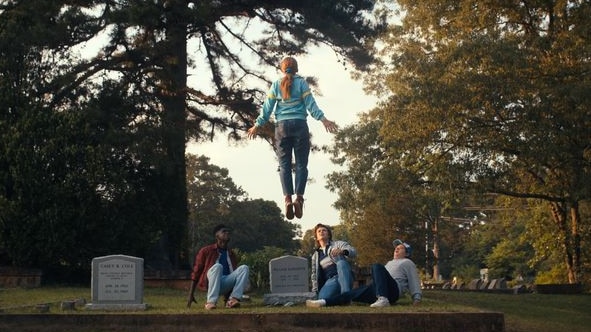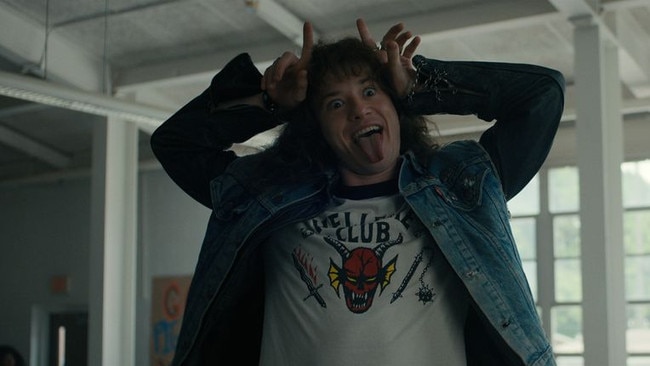Stranger Things: caught in the satanic panic of 80s TV
The new season of Stranger Things grows up — and leans into the darker aspects of 1980s culture.

The panics over satanic cults, heavy metal, Dungeons & Dragons and other perceived evils that once freaked out America have arrived in the 1980s of Stranger Things.
The poster boy for the era’s occult paranoia is Eddie Munson, a new character played by Joseph Quinn. In the show’s fourth and penultimate season, he’s a repeat senior student at Hawkins High School and the leader of its D&D group, the Hellfire Club. He is an alpha misfit who plays in a metal band, sells some drugs on the side, and rants about conformity.
And he becomes a scapegoat for grisly stuff occurring in Hawkins.
Six years after the debut of one of Netflix’s biggest hits, Stranger Things is getting more adult along with its core ensemble, played by actors now in their late teens and early 20s. Season four, set in 1986, leans into the horror genre with a threat reminiscent of the spectres in A Nightmare on Elm Street (1984), the Stephen King novel It (1986), and Hellraiser (1987).
The show’s creators and writers, Matt and Ross Duffer, the 38-year-old twins billed as the Duffer Brothers, said the new season mirrors the rite of passage their characters are navigating.
“For so many teens, high school is a difficult time – it certainly was for us. Insecurity, anxiety, and depression are all quite common, and we wanted to explore all of that,” the Duffers say in a jointly written email. “This immediately gave the season a bleaker tone, and so it felt both tonally and thematically appropriate to also examine the darker aspects of ’80s culture.”

Eddie’s first scene foreshadows a witch hunt. Holding court in the school cafeteria with his Hellfire Club disciples, Eddie flashes devil horns at the jocks and reads aloud from an issue of Newsweek magazine. An article links D&D, he quotes, to “satanic worship, ritual sacrifice, sodomy, suicide and even … murder!”
In real life, that magazine was one of many influential media outlets that gave credence to fears about the role-playing game that had exploded in popularity. A Newsweek article published in 1985 quoted religious leaders and parents who claimed players got lost in a fantasy world of monsters and sorcery with deadly results. Sources in the article included the organiser of a group called Bothered About Dungeons & Dragons, who linked her son’s suicide to a curse put on his game character.
To research the D&D panic and related scares of the 1980s, the show’s writers had plenty of archival sources to draw on. They ranged from a 60 Minutes segment investigating the game’s role in deadly incidents, to a 1982 made-for-TV movie that dramatised one of those events, Mazes and Monsters, starring a young Tom Hanks.
Dungeons & Dragons, first published in 1974, has been core to the Stranger Things mythology from the start. The characters named the supernatural enemies they faced – the Demogorgon, the Mind Flayer – after entities in the game. The Duffers said they always planned to incorporate the real-life anxieties about D&D, but season four was the first time it made sense to do so in the story.
As gruesome events plague Hawkins, the townspeople gather to point fingers. One local says: “We’ve all heard satanic cults are spreading through the country like some disease.”
The show ups its levels of scariness and fantasy violence in the new episodes. Netflix recently removed a teaser sequence from the internet and added a warning to viewers in the wake of last month’s mass shooting in Uvalde, Texas.
Regarding Quinn’s character, they say: “He is both a metalhead and a dungeon master, a nerd and punk, dangerous but sweet, talkative and a little rambunctious, but – and this was the real trick – more charismatic than annoying.”
The producers first imagined Eddie as a guy with the energy Quentin Tarantino might have had in high school if delivering a monologue from atop a cafeteria table.
Viewers might be reminded of a young Robert Downey Jr. by Quinn’s arched eyebrow and puckish performance.
The actor credits Eddie’s mane of long hair for helping him get into character. “Just putting the wig on, man,” Quinn says. “It was done for me.”
Quinn is an English actor who has done work in more buttoned-up period dramas like Howards End, Les Miserables, and Catherine the Great. He loses his British accent in Stranger Things and dons the uniform of a metalhead. Tight jeans with a chain wallet. Leather jacket and denim vest with a big patch on the back: Dio.
Like D&D, bands such as Dio were frequently targeted as gateways for devil worship or cult violence. Both Ozzy Osbourne and Judas Priest were sued, and eventually cleared, over musical messages that had been blamed for suicides in the 1980s.
“Heavy metal flies in the face of all the white picket-fence Christian values that kind of ruled America,” Quinn says. “I can understand why it was received in an alarming way. Monstrous looking young men with satanic paraphernalia.”
Stranger Things is streaming on Netflix.
The Wall Street Journal


